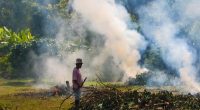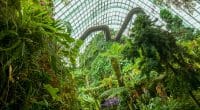Two-thirds of the world's population are expected to live in urban areas by 2050. Aware of the role of trees in urban life, it is becoming increasingly important to promote urban forestry. In this article, Zhimin Wu, Director of the Forestry Division at the Food and Agriculture Organization of the United Nations (FAO), explains the challenges of urban forestry. He also looks at the situation in Africa. Sierra Leone in particular.
A few years ago, a university professor proposed the “3-30-300” rule. This envisages a world in which every individual can see at least three trees from their window, live in a neighbourhood with at least 30 per cent tree cover, and be no more than 300 metres from high-quality urban green spaces.
With two-thirds of the world’s population expected to live in urban areas by 2050, this rule is not just about making cities greener because of the many benefits of trees and green spaces. It is also, and crucially, about ensuring that all city dwellers benefit.
We know that trees and green spaces, also known as urban or peri-urban forests, help to alleviate many of the disadvantages of living in an urban environment.
They dampen noise and filter pollutants from traffic and industry, helping to protect against respiratory diseases. They provide space for exercise, recreation and stress relief. The beneficial effects on mental health of contact with forests and green spaces are already well documented.
Urban forests also mitigate the effects of climate change. In the face of rising global temperatures, they not only absorb carbon, they can also cool city air by up to 8 degrees Celsius and reduce the urban heat island effect, which can be fatal during heatwaves. They can even provide protection against natural disasters such as floods and landslides.
The need for equal access to urban green spaces is recognised by the United Nations Sustainable Development Goals, which include a specific target to ensure access for all, especially women, children, people with disabilities and older people, to safe, inclusive and accessible green and public spaces by 2030.
However, a new study published this week by the Food and Agriculture Organization of the United Nations (FAO) reveals that urban populations are still a long way from benefiting equitably from urban forests and green spaces.
The study Urban forests: a global perspective finds that, particularly in low- and middle-income countries, rapid urbanisation without adequate planning often leads to cities with few or poorly placed trees and green spaces.
Even in cities that recognise the importance of green spaces in their urban fabric, the distribution of these spaces and their benefits is often skewed in favour of wealthier neighbourhoods. So-called ‘green gentrification’ can further limit the accessibility of these spaces for residents who can no longer afford to live close to their city’s green spaces.
In many places, disadvantaged communities continue to be excluded from the planning, design and management of urban green spaces.
And this must change
That’s why participants at the second Global Forum on Urban Forests, held this week in Washington DC, issued the Washington Declaration, which sets out an action plan to make the greening of cities more equitable.
This includes analysing urban areas to identify imbalances in the distribution of green spaces, and involving residents and local officials at every stage of the planning process.
While a world populated by urban utopias may still seem a long way off, there are programmes and initiatives that suggest that various planning authorities are thinking more inclusively about equal access to urban forests and the riches they offer.
Governments around the world are devoting more funding to urban greening programmes.
For example, the town of Maringá in southern Brazil plants trees in the most deprived areas on the outskirts of the city to improve air quality and provide shade for residents during the hot, muggy tropical summers.
In China, the municipal government of Guangzhou aims to build 4,500 km of greenways by 2035, so that 90 per cent of its citizens live within 300 m of the nearest neighbourhood park and within 1,000 m of the nearest urban park.
And in Sierra Leone, the “Freetown the TreeTown” campaign encourages residents of the capital’s disadvantaged neighbourhoods to plant and maintain trees. As an added incentive, participants receive mobile phone credits by using an application that monitors the progress of the seedlings.
The importance of urban forests in human health and in mitigating and adapting to the effects of climate change is increasingly recognised worldwide, notably by the Intergovernmental Panel on Climate Change and the Kunming-Montreal Global Biodiversity Framework, which calls for the enhancement of urban green and blue spaces for human well-being.
But if the world is to achieve its global objectives, all urban populations, not just a privileged few, must have access to green spaces.
By Zhimin Wu,
Director of the Forestry Division at the Food and Agriculture Organization of the United Nations (FAO)





